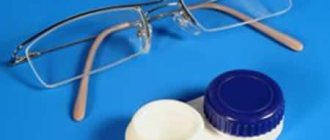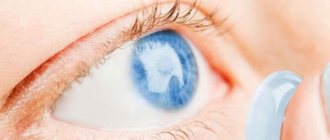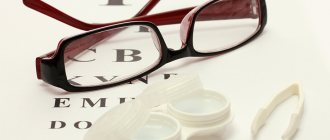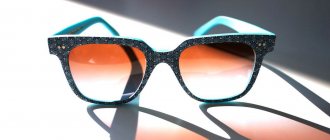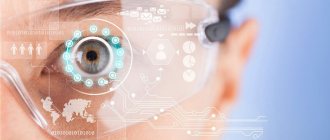Progressive lenses
A distinctive feature of the products is that the eyepieces have a certain optical power in different areas. The upper part is used when you need to consider objects located at a distance. It provides the necessary degree of focusing.
The lower half of the lens is used when working with small particles, and helps to focus the gaze on objects nearby. This difference in optical power is called addition; it should not exceed three diopters.
| The line between the top and bottom is not clearly defined. The sections flow smoothly, at the place where they “meet” the optical power has an average value. |
How do progressive lenses work?
The products belong to the category of multifocal optics. Provides perfect visibility both near and far. A similar effect is achieved due to the unique surface of the eyepieces, on which the radius of curvature changes not only vertically, but also horizontally.
As we have already said, the difference between the top and bottom of the lens is no more than three diopters. The two sections are connected by a progression corridor, in which one optical power smoothly replaces the other. The canal is parallel to the bridge of the nose.
Thanks to the presence of a “bridge,” a person maintains visual acuity at intermediate distances. On the sides of the channel there are “blind zones” that create optical distortions. Therefore, looking through them is strictly prohibited.
Such products are preferred by people who often have to change glasses while doing work, since they need to focus at different distances. Progressive lenses require a special frame that meets certain parameters:
- Height of at least twenty-seven millimeters;
- Sufficient forward tilt;
- A certain distance between the pupil and the inner surface of the eyepiece.
Return to contents
Glasses
The glasses consist of a frame with glass or plastic lenses that sits on the bridge of the nose and is supported by two earpieces that rest on the ears.
Glasses are available in several options, most notably: Regular monofocal glasses
- They only have one focus, so they can be used to help the wearer see things that are far or close, but not both.
Glasses with bifocal lenses
- allow the wearer to see things that are far away and those that are obscured. For example, they can be worn for driving and reading a book. Bifocals often have a noticeable line or crescent shape in the middle of the lens because two parts of the lens—the part used for seeing things up close and the part used for seeing things far away—are contained within the same lens.
Glasses with trifocal lenses
- allow the owner to see things that are far away, at an average distance, like a computer screen or a book.
Eyeglass lenses are often clear, but may be tinted for aesthetic reasons or for use as sunglasses. Some glasses change opacity when exposed to sunlight, turning into sunglasses when the wearer steps outside into bright light.
Other types of glasses include: Progressive lenses
- these lenses are multifocal, such as bifocals and trifocals, but they do not have a line in the front, as bifocals often do.
Adjustable lenses
- The focus of these glasses can be adjusted by wearers while they are wearing them. The way it works is each lens is filled with liquid. The wearer can move the slide or switch glasses, which change the shape of the liquid, which changes the focus of the glasses.
Aspherical lenses
- They are thinner than most other types of eyeglass lenses and are often used for aesthetic purposes when the user wants to avoid a very thick lens.
Plan lenses
- These lenses have no focus and are basically just clear sheets of glass or plastic. They are used in glasses that are worn purely as accessories, or used on one side of a pair of glasses when a person has poor vision in one eye but excellent vision in the other.
All types of glass should be cleaned regularly using a microfiber cloth and a cleaning solution or mild mixture of soap and warm water. This helps ensure that the user can see correctly and can also prevent the lenses from being scratched. Glasses should be stored in a hard case when not in use to keep them from getting dirty and protected from damage.
Most eyeglass lenses require a prescription, but there are non-prescription soft corrective glasses available for reading, or less commonly, for nearsightedness. Although these glasses are usually less expensive than prescription glasses, they are not tailored to the person wearing them and in some cases can worsen eye problems.
Indications and contraindications
People over the age of fifty often experience an increase in the range of blurred focus, in other words, they see poorly at different distances. A person cannot see objects located at a distance and focus on nearby objects. For each type of activity it is necessary to select a separate corrective optics.
Progressive glasses help solve this problem; they cope well with age-related changes in the visual system. However, the products have a number of contraindications for use:
- Anisometropia. An ophthalmological disease when the difference in refraction between the left and right eyes is more than two diopters;
- Cataract. It is almost impossible to achieve stable vision correction, since lens clouding develops rapidly;
- Strabismus of any origin. The pathology does not allow simultaneous movement of the organ of vision across three zones of multifocal glass;
- Nystagmus (pupil trembling). The anomaly causes optical distortions in different parts of the lens; adapting to them with this disease is problematic;
- Individual intolerance to corrective glass.
Features of choice
The technology for producing advanced glass is developing at a rapid pace. No ophthalmologist can give an exact answer to the question of which lenses are best. Since each person is individual, when choosing optics, the doctor pays attention to the state of health, characteristics of the visual apparatus, etc. Professional activity, rhythm of life, etc. are also taken into account.
| If the work involves small details, then it is better to avoid progressive lenses. The products are not recommended for people who, due to their duties, have to write a lot or drive for a long time. |
Some products have unique features. For example, BBGR Corporation produces a product for left-handers. Seiko offers eyepieces for drivers. These glasses provide full visibility and good visual acuity.
Also on the market you can find products for patients suffering from myopia or hypermetropia. When selecting lenses, the optometrist takes into account the person’s financial situation. Many corporations offer thin and thick glass. The latter are characterized by a low price tag, but the former are of high quality. True, thin lenses have a number of nuances when used and are not suitable for all people.
Types of progressive optics
There are three types of glass, which differ in the size of the zones, cost and level of adaptability to human needs.
Standard type
To create them, take classic blanks. They are characterized by a small width of “useful” areas. They have the lowest price of all progressive lenses.
Customized type
Included in the premium price category. One surface has a standard progression, and the second is created in accordance with the doctor’s recommendations. The “working” zones are several times wider than in standard products. Wearing such glasses with progressive lenses is much more comfortable, and getting used to them is faster.
Individual type
The product is created specifically for a specific person, taking into account the characteristics of his lifestyle and the structure of the organ of vision. They have a high price tag because they do not use classic blanks in the manufacturing process.
Optics takes into account individual parameters - size and type of frame, wearing style, occupation, etc. In these eyepieces, the “working” areas are the widest, so the visibility area is maximum. Return to contents
Contraindications
Progressive lenses are not recommended for patients with anisometropia (different eye refraction, that is, a difference in diopters). For cataracts, wearing glasses is ineffective due to clouding of the lens.
Nystagmus does not allow the use of progressive spectacle lenses due to instability of the pupil in the progression channel, which can result in the gaze falling into areas of distortion. With strabismus, it is impossible to maintain parallel lines of movement of the eyeballs in the main directions of progressive glasses, that is, near, middle and far.
Representatives of some professions need to select progressive glasses with special care. These are librarians, cosmetologists, surgeons, pilots, car mechanics, hairdressers, dentists, jewelers, violinists, crane operators. The work of these categories of patients requires the use of specific visual lines, so the choice of progressive glasses should be made more carefully.
Glasses with progressive lenses are a convenient means of correcting age-related changes in vision. Correctly selected lenses are the key to restoring normal visual function. Advanced optical systems make it possible to see the world clearly again, read books and lead an active lifestyle.
Sources used:
- Clinical ophthalmology. Book 1 / I.I. Merkulov. - M.: Book on Demand, 2012.
- Ways to compensate for blindness / M.I. Zemtsova. - Moscow
- The day begins at dawn (overcoming blindness) / S.R. Muchnik. - M.: Knowledge, 1982.
- “Eye Microsurgery” named after Academician S.N. Fedorov" of the Ministry of Health of the Russian Federation
Pros and cons of progressive lenses
Unique products have several undeniable advantages:
- The ability to use the same glasses to achieve good visual acuity at different distances;
- Thanks to the presence of a special “bridge,” there is no sharp jump when moving the gaze from one object to another, which causes optical discomfort. Bifocal lenses have this disadvantage;
- The line between the upper and lower sections is not visible. Visually, the eyepiece looks solid;
- Glass and plastic are used to make goods. This allows you to create products for consumers in different price categories.
However, progressive lenses are ideal only at first glance; they also have several disadvantages:
- Narrow peripheral viewing area. To examine an object, you need to tilt your head down or turn towards the object;
- The presence of “blind spots” on the sides of the glass. They can distort the picture, so it is not recommended to look through them;
- The need to get used to, the patient has to turn his head at a certain angle to achieve clear focusing. You won’t be able to simply rotate your eyeballs like you would with regular glasses;
- High price.
The process of adaptation to the product lasts several days and does not cause any discomfort. For some people, eyepieces are contraindicated due to the nature of their professional activities. For example, musicians playing the violin. While performing the melody, the artist looks at the lower left corner, where the distortion zone is located. In this case, it is better to stick to classic lenses.
| Also, doctors, drivers and those whose work requires pinpoint precision (for example, a car mechanic) should be approached with special care when choosing eyepieces. |
What are the special glasses for distance and reading called?
Optics for reading, for distance and for constant wear are called progressive. An ophthalmologist prescribes a prescription for permanent wear after a complete diagnosis. In glasses with lenses that support accommodation, a myopic person who already has age-related farsightedness will see equally well at different distances, since these lenses have several optical zones. These glasses can and even need to be worn all the time; a second pair is not required. Thanks to the special features of the optics, the transition from close zones to medium and distant zones is smooth and imperceptible.
Should I switch to glasses that support accommodation? These optics are recommended for wearing by people who have difficulty getting used to reading glasses. With their distance glasses, they see normally at a distance, but up close the picture is blurry. Even if they wear special reading glasses, they still do not feel adequate comfort when looking at close objects. In this case, it makes sense to choose progressive glasses, since distance glasses, due to existing presbyopia, can no longer provide the necessary optical conditions.
Symptoms of presbyopia in nearsighted people:
- rapid eye fatigue even with low visual load;
- blurry vision at close range;
- severe discomfort when reading, working with small objects.
If you have some of these symptoms, consider replacing your long-distance optics with advanced optical products. They have a lot of advantages:
- several correction areas;
- lack of visible transitions;
- smooth transition between optical zones;
- clear, contrast vision at different distances;
- visual comfort all day long.
Those who prefer contact vision correction can choose special lenses. Contact optics, similar in functionality to progressive glasses, are called multifocal. Dailies Total1 Multifocal multifocal contact lenses have proven themselves well, they are worn one day, and the next day they take out a new pair, without worrying about cleaning and disinfecting ophthalmic products.
Rules for using progressive glasses
The products are comfortable to wear, but you will have to spend several days adapting. You need to learn how to use eyepieces correctly. Some rules will make it easier and faster to get used to:
- After purchasing progressive optics, hide your old glasses in the farthest corner and do not use them;
- To use peripheral vision at medium and far distances, turn your head slightly in the desired direction;
- Achieving optimal gaze fixation will require training. Do a simple exercise: move your gaze from a close object (for example, a cup of coffee in your hand) to a distant object (a plant behind glass) and to one that is located in the middle distance (a wall clock);
- To read magazines and books, choose the optimal position by changing the direction of your gaze. Most often, the working distance exceeds the usual forty centimeters. After some time, focusing will be carried out automatically;
- Using a ladder, apply the intermediate area on the lenses. To do this, you need to tilt your head down a little;
- You can drive a car only after you have mastered the above skills. Begins to become comfortable with progressive lenses on lightly trafficked routes where less concentration is required. Because at first the brain is busy only with adapting to optics.
| Train every day for thirty minutes until all your skills become automatic. Once fully accustomed, you will appreciate the benefits of the product. |
However, there are people (about 15%) who never manage to “make friends” with progressive lenses. For this case, special exchange programs operate. If the product is not suitable, the consumer has the right to exchange them for single vision ones. True, the full cost of the goods is unlikely to be returned.
Properly selected frames help you get used to wearing glasses. In some cases, the help of a specialist is required; he will correct a number of shortcomings that prevent you from getting used to the lenses. The product requires correction in the following cases:
- Presence of peripheral distortion;
- To view a distant object, you need to slightly tilt your head forward, and when reading you have to raise your glasses;
- In one of the areas or in both areas at once, low image clarity is noted;
- A very small reading area; distortion is observed when moving the gaze along the progression channel.
Return to contents
Disadvantages of progressive glasses
The patient should be aware of the difficulties that he may encounter during the period of adaptation to progressive glasses and be prepared for them:
- a longer period of adaptation compared to monofocal glasses - there are no specific deadlines, in some cases adaptation can last a month, but this should be said in order to avoid misunderstandings;
- restriction of head movements up and down when working at close distances - at the time of marking, you should focus on this and offer a short corridor if a long one is inconvenient;
- a greater number of distortions when looking through the peripheral part of the lenses in comparison with monofocal glasses - at the beginning of wearing, try to look through the center of the lenses;
- difficult to see when looking at your feet while walking (problems with stairs, holes, puddles) - to see better, you will have to tilt your head lower.
10 tips to help your patients quickly get used to new glasses
Exercises to get used to glasses
When you wear progressive optics for the first time, you will have to spend two to four days adapting to them. It is better to start the habituation process at home, for example, on weekends. A number of training methods have been developed to speed up the adaptation process. They consist of the following techniques:
- Walk on stairs and sidewalks. Get used to looking at the steps and at your feet through the middle area of the eyepieces. To do this, you will need to lower your head slightly to avoid tripping. To practice the technique, you need to spend at least half an hour every day;
- Looking to the side. It is not enough to simply avert your eyes; you will need to slightly turn your head towards the object in question. Set aside twenty minutes every day for training. Move your gaze to objects located on the sides at different distances.
| It is not recommended to select optics yourself, as this can cause serious harm to your eye health. |
Cost of products
The price of progressive optics depends on several factors:
- Manufacturer;
- Lens thickness;
- Progression channel width (transitional area between the top and bottom). The higher the indicator, the higher the price.
On average, the cost of a quality product from a popular manufacturer ranges from four to nine thousand rubles, depending on the technical characteristics. Expensive optics are produced under the brands Essilor International and Rodenstock. The price of products from these companies is around fifteen or seventeen thousand rubles.
Less popular brands offer a good product with a price tag of two to four thousand. However, their service life is short.
Intraocular lenses
Intraocular lenses are actually implanted into the eyeball, sometimes to replace a lens that has been removed or rendered unusable due to cataracts or glaucoma, but also simply to correct vision. Most intraocular lenses are monofocal, which means the user may have trouble focusing at distances other than what the lens is designed to focus on.
They are mainly focused on distance vision, although multifocal intraocular lenses are available.
Intraocular lenses can be placed in approximately 30 minutes by an experienced ophthalmologist in an outpatient procedure. Recovery time after receiving intraocular lenses is usually two to three weeks. Because intraocular lenses are not removed, they do not require care while they are in the eye, but during the recovery period after the lens is implanted, the user cannot do strenuous exercise or things that increase his or her blood pressure.
How do corrective lenses work?
Corrective lenses work by using bending light to move the focal point of light coming closer or further into the eyes.
In a normal eye, the natural lens of the eye bends this light to the right length so that it is focused on the retina, the back of the eye, and the eye can focus without assistance, but some people's eyes bend the light so it is focused in front of the retina or at a point behind the retina, which makes their natural vision unfocused. People with nearsightedness have an eye shape that causes light to focus in front of the retina, so they need lenses that move the focal point farther away so they can see things at a distance. Farsighted people have eyes that focus light on a point behind their retina, so they need lenses that bring the focal point closer so they can see objects up close.
The depth of the correction lens curve, the thickness of the lens, and the precise shape of the lens can be used to change the focal point. Even small changes in the degree of lens curve can significantly affect vision. Lenses for certain nearsighted individuals are convex and have a thin, tall shape, while farsighted lenses are concave and have a middle section that is thinner than the ends.
There are also special types of corrective lenses for people with astigmatism. While those who are nearsighted either have longer or egg-shaped eyeballs, and those who are farsighted have eyeballs that are shorter than normal, those with astigmatism have irregularly shaped corneas rather than eyeballs, making them vision blurred. People with astigmatism need a special type of correction lens called a toric lens, which bends light more toward one part than another.
The power of a correction lens is measured in diopters, which is written as a plus or minus in the lens sentence. Thus, a lens measuring 2.5 diopters for a person who is nearsighted would be written as "-2.5" on his or her prescription or in the contact lens box. The lenses below are classified according to their diopter and are used by ophthalmologists during eye examinations to determine what level of prescription a person needs.
Most people can discern quarter-diopter changes, so most corrective lens prescriptions are written in quarter-diopter quantities (+1.00, +1.25, +1.50, etc.). Diopter measurements are often written negatively for myopia and positively for farsightedness, although this can often be the other way around.
Pros and cons of corrective lenses
Some studies suggest that in individuals with borderline nearsightedness or farsightedness, especially children, wearing corrective lenses may lead to lens dependence and may impair their vision, but this has not been conclusively proven. For most people, wearing corrective lenses of the appropriate prescription will not cause vision impairment.
Wearing incorrectly prescribed corrective lenses can cause eye strain, headaches and dizziness, and wearing the wrong contact lenses, especially those that do not fit the eyes properly, can lead to serious eye problems, including scarring.
Despite this, corrective lenses are valuable for correcting vision and may be a necessity to drive, perform some types of work, read, or for a good quality of life.
Pros and cons of specific lens types
Pros of glasses:
- Glasses are often cheaper than contact lenses and intraocular lenses, although choosing designer frames can significantly increase the cost.
- Glasses also don't need to be cleaned as often as contacts do.
- Sometimes glasses correct astigmatism better.
- Some people also find that glasses suit their personal style better than contacts or intraocular lenses.
- Almost everyone can wear glasses.
- They are easier to put on and take off than contacts.
Cons of glasses:
- Glasses can fall and are sometimes fragile.
- The glasses are foggy.
- Glasses may have glare and reflections, although this can be mitigated by an anti-reflective coating.
- Glasses do not provide good peripheral vision like other types of lenses.
- Some people find glasses bulky and feel they don't suit their personal style.
- Glasses are often not suitable for sports.
Advantages of contacts:
- Contacts provide natural vision with good peripheral vision.
- The contacts do not fog up or cause glare or reflections, as can sometimes happen with glasses.
- Contacts are often better for sports.
- Aesthetically, some people prefer not to wear glasses, or find that wearing contacts is a more natural option.
Disadvantages of contacts:
- Contacts require frequent cleaning.
- Some people find contacts uncomfortable and sometimes find them difficult to wear.
- Contacts may fall out and be difficult to find if they fall out.
- Contacts can be more expensive than glasses.
- Many types of contacts must be removed for sleeping, which can be tedious.
Pros of intraocular lenses:
- After receiving intraocular lenses, a person typically no longer needs glasses or contacts.
- For those who receive intraocular lenses after cataracts, the cataracts almost never return.
- Intraocular lenses are an alternative for those who cannot undergo surgery.
- Intraocular lenses can be implanted in a quick outpatient procedure.
Disadvantages of intraocular lenses:
- Intraocular lenses are often more expensive than contacts or glasses, depending on a person's insurance policy.
- They require implantation into the eye, which can cause complications.
- Multiple intraocular lenses can only be inserted into people over 40 years of age, as eye growth can impair the function of the lens.
- Many types of intraocular lenses are monofocal and limit a person's focus to that of the lens.
- Since most intraocular lenses are geared toward distance vision, a person may still need reading glasses.
Alternatives to Corrective Lenses
The simplest alternative to corrective lenses is to simply not wear them and live with your vision impairment.
Other alternatives to correct vision include: Refractive eye surgeries such as radial keratotomy, automatic lamellar keratoplasty, and limbal relaxing incisions. Laser eye surgery and laser thermal keratoplasty.
Orthokeratology, which is a procedure for reshaping the cornea by wearing rigid gas permeable contact lenses, usually at night, which gradually changes the shape of the cornea.
Popular manufacturers
Currently, products from several manufacturers are in demand on the market, creating a high-quality product at an affordable cost:
- Rodenstock. Offers products for consumers in the middle price category;
- Seiko Optical Europe. The company has released a line of progressive optics designed specifically for car enthusiasts. The corporation also sells standard products;
- BBGR. Unlike other manufacturers, the company takes into account the visual characteristics of left- and right-handed people;
- Essilor International. Products under the brand name cost more than eyepieces from other companies. At the same time, their progressive lenses are of high quality and are presented in a wide range;
- Shamir Optical Industry Ltd. The corporation produces products of various shapes, taking into account the degree of addition. The differences in quality between products from these manufacturers are small. The only difference is the price tag, which depends on the reputation and time on the market.
